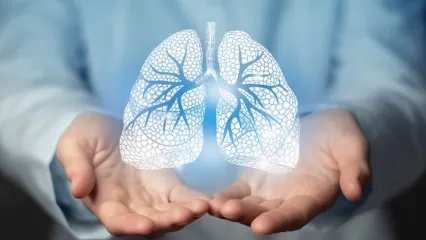Alo Yeditepe
Alo Yeditepe
What is Allergy? What are the Symptoms of Allergy?
What is Allergy?
Allergy is when our body reacts to substances that are normally harmless as if they were threats. It's actually a defense mechanism, but when the body encounters something harmless, it activates the immune system as if it were a harmful substance, triggering a reaction.
What Are the Symptoms of Allergies?
In allergic individuals, symptoms such as watering and itching of the eyes, sneezing, nasal congestion, postnasal drip, coughing leading to sleep problems, shortness of breath, sensation of not getting enough air while breathing, pressure on the chest, or signs of allergic reactions such as dermatitis on the skin provide clues that there may be an allergy.
Who Are at Risk for Allergies?
Individuals with a family history of allergies, meaning those with genetic predisposition, those working in high-risk occupational groups exposed to chemicals and harmful particles, those exposed to all tobacco products including electronic cigarettes, those exposed to air pollution, and individuals under intense stress are at higher risk.
When is Allergy Most Commonly Seen?
Allergic reactions are generally associated with environmental factors, and it's true that these factors can vary with seasonal changes.
With climate change, seasonal variations have occurred. Along with seasonal changes, there has been a shift in the pollen burden due to changes in tree species and pollen development. Therefore, we can say that with climate change, the timing of allergy seasons has also changed..
Some people are sensitive to allergens such as pollen, fungal spores, or mold, and the amount of these allergens can vary by season. For example, pollen levels may increase during spring and summer months, while the number of mold and fungal spores can rise under humid conditions..
The dates when cases are observed have also changed. While intensity used to increase in early March, now it could be said to have shifted from early April to the end of May.
However, allergy is not limited to specific seasons. Allergy symptoms can persist throughout the year for an individual, especially if they have sensitivity to indoor allergens (such as pet dander, dust mites). Therefore, allergic reactions can occur in every season and can vary depending on the environmental factors, genetic predisposition, and personal sensitivity of the individual.

What Are the Types of Allergies?
There can be various relationships between allergies and lung diseases. Especially, asthma is a condition where allergic reactions cause inflammation and narrowing of the airways, so allergies and asthma are often seen together. Exposure to allergens can trigger or worsen asthma symptoms.
Additionally, allergic reactions can sometimes cause inflammation and narrowing of the airways in the lungs, which is known as a specific condition called allergic bronchitis. This condition arises as inflammation of the respiratory tract and as an allergic response to allergens.
Among the most commonly observed conditions related to allergy in relation to lung diseases are asthma, allergic rhinitis (hay fever), and allergic bronchitis. Therefore, evaluations such as allergy tests and lung function tests can be conducted in individuals with respiratory symptoms associated with allergic reactions, and appropriate treatment plans can be established.
In addition, it is known that allergy patients who smoke are at a higher risk of developing COPD.
What Happens if Allergies are Left Untreated? When Should Allergies Be Treated?
If a person has symptoms of allergy, it should definitely be treated. Because in the case of allergy, there is tissue damage, a reaction. A compromised immune system due to excessive reaction poses a risk for other infections. Secondly, especially in patients with untreated allergic rhinitis or allergic asthma, risks such as deterioration in sleep quality, increased susceptibility to pneumonia, worsening of asthma treatment, and increased risk of attacks also increase.
Especially in the elderly age group, since the immune system is already weaker, we anticipate that pneumonia will be more severe. In these patients, since untreated allergies will also have a negative effect on the immune system, treatment becomes even more important in the adult or elderly group. Because in a group, nasal congestion, disruptions in sleep quality due to postnasal drip impair the quality of life of patients..
How Is Allergy Treated?
Today, including the elderly, we can achieve very successful results in 80% of patients with standard first-line treatments for allergies. Depending on the patient's condition, we can adjust their treatments with step-wise therapy.
There are various medications available to relieve allergy symptoms. Medications such as antihistamines, nasal sprays, eye drops, and decongestants can be effective in controlling symptoms. Immunotherapy, which is an effective treatment option for reducing allergy symptoms, aims to increase the body's tolerance to allergens. This treatment involves administering small doses of allergens at regular intervals. Over time, the body may show less reaction to allergens. Additionally, one of the most important steps is to avoid allergens that cause allergic reactions. For example, someone with pollen allergies should spend less time outdoors during periods of high pollen levels. Similarly, avoiding allergens as much as possible in work and living spaces can also be beneficial.

What Should People with Allergies Pay Attention to?
• Allergens should be avoided as much as possible. For example, those with pollen allergies or asthma should avoid going out, if possible, during the hours of high pollen levels, around 10 in the morning and 4 in the afternoon, or should wear a mask and sunglasses when going outside.
• When ventilating the house, attention should be paid to these hours as well.
• Instead of parking their cars in the shade under trees, people should park in open areas away from pollen, and the air conditioner filters of vehicles should be regularly checked and replaced.
• During pollen allergy season, especially after being outdoors, clothes should be changed upon returning home, and hands and face should be washed to remove pollen.
• Laundry should be dried indoors, preferably in a dryer, rather than outside on the balcony.
• To reduce allergen levels at home, dusting should be done regularly, preferably without using carpets; if used, carpets with minimal pile that are easy to wash should be preferred. Beddings should be washed weekly. Additionally, anti-allergenic bedding sets and pillowcases can be used for those allergic to dust mites.
• Those allergic to pets should limit contact with pets or choose breeds with low allergen levels when acquiring pets. Additionally, replace carpets and fabrics in the house with materials that can easily clean pet hair.
• Improve indoor air quality by using HEPA-filtered air purifiers and air conditioner filters. These devices can reduce the risk of allergic reactions by removing allergens from the air.
• Keep humidity levels in check at home to prevent the growth of mold and fungal spores. You can use dehumidifiers to keep humidity levels low or ventilate humid areas like bathrooms and kitchens. Avoid having plants that would increase mold growth in the house.
• To control allergy symptoms, antihistamines, nasal sprays, or eye drops recommended by your doctor should be used regularly.
• Tobacco and tobacco products should absolutely not be used, and individuals should not be present in environments where they are used. Smoking triggers allergic reactions in all allergic individuals. Regardless of how much allergen exposure is reduced, smoking alone can cause allergic reactions.
Allergy is already a disease that significantly affects quality of life, and as with all chronic illnesses, close monitoring and individual awareness are crucial. If the patient remains under proper monitoring and treatment, they can continue their life in a very high quality without experiencing the negative effects of these complaints.
Frequently Asked Questions About Allergies
Is Allergy Contagious?
Allergy is not contagious. There is an observed increase in the number of allergies and allergic respiratory diseases both worldwide and in our country. It is emphasized that there could be many underlying reasons for this trend.
Although many ideas such as Covid, the post-Covid period, and vaccines are put forward, the most fundamental problem is attributed to various factors such as climate change, industrialization, increased stress, and air pollution triggers. It can be said that the increase in the number of cases is due to various factors, including the exposure of individuals who normally have allergies but whose clinical symptoms have not yet emerged to triggers.
Which Allergens Are More Intense?
When we look at allergy cases related to respiratory and food groups, it can be said that the number of respiratory allergens has increased in clinical practice. The main factors here include, as mentioned, the emergence of triggers such as increased air pollution, reduced air circulation, and of course, the increase in tobacco use.
How Do Upper Respiratory Tract Infections Differ from Allergies?
During the Covid pandemic, we wore masks for three years, so we stayed away from many virus infections during this period. However, with the decrease in mask usage, we started to see many more viruses and the diseases they cause, especially the influenza virus. It is observed much more severe and widespread.
The most important differentiating symptom that indicates whether the problem is an allergy or an infection is fever. Fever is not observed in allergy cases. The second distinguishing point is the duration. We know that a viral infection will not last more than 7 to 10 days. If a person's symptoms such as runny nose, postnasal drip, sneezing, or sore throat persist for more than 10 days, we tend to say that it is no longer a viral infection but an allergy. Because viral infections are self-limiting infections that resolve on their own within a week to ten days even without treatment.
Do Environmental Factors Trigger Allergies?
Allergy is essentially a clinical condition that arises when a person's genetic predisposition combines with the external environment. If a person has a genetic predisposition, they may react to an allergen to some extent. However, if there are triggers present, or if they are experiencing a viral infection, or if exposure has increased, their symptoms worsen, and allergies become evident. There are no new types of allergens emerging apart from the classic allergens. However, it's worth emphasizing that there has been a significant increase in the number of patients seeking medical attention for allergy-related conditions worldwide. It can be said that this increase is influenced by individuals with genetic predispositions being exposed to triggers more frequently.
What is the Hygiene Hypothesis?
The hypothesis of hygiene suggests that if the body cannot find a bacterium or virus to fight against, it may develop allergies to harmless particles such as pollen. Therefore, one of the reasons why people living in hygienic environments may have more allergies could be this. Consequently, with the influence of this hypothesis, we have started to see allergies in older ages as well. While we used to see allergies more in the middle age group or in the younger age group in the past, now we are seeing new allergies emerging at much older ages in society. This result can also be attributed to the hygiene hypothesis. Although the number of new allergies diagnosed in individuals over 60 is generally much lower, we are now witnessing a significant increase in the number of new allergies emerging in this age group.
About
Faculty and Year of Graduation:
Gazi University Faculty of Medicine, 2007
”
See Also
- How to Cleanse Your Lungs?
- Is Breathing Air Dangerous in Fires?
- What is Electronic Cigarette Disease (EVALI)? EVALI Symptoms and Treatment
- What is COPD? Symptoms and Treatment of COPD
- Long Journeys Increase the Risk of Embolism!
- What Asthma and COPD Patients Should Pay Attention to When Using Air Conditioning!
- What is Desert Dust? Harms of Desert Dust
- Lung Cancer Screening Age
- What is Good for Cough? How to Cure Cough?
- Lung Cancer Symptoms and Treatment
- 10 Ways to Have a Sound Sleep in the Heat
- What Should Asthma Patients Be Cautious About?
- Does Poor Quality Sleep Increase The Risk of Asthma?
- What Causes Insomnia, Diagnosis and Treatment
- 9 Common Misconceptions About COPD
- Causes, Symptoms, and Treatment of Asthma
- Allergy and Asthma During Pregnancy
- It Is Aimed to Eliminate Tuberculosis Worldwide By 2030
- Lung Patients Should Not Stop Their Medications
- 4 Significant Preliminary Symptoms of Lung Cancer
- How Does Acid Rain Affect Human Health?
- The Slowing Traffic in Istanbul Increases the Risk of Cancer!
- The American Cancer Society Has Announced; The Age of Screening For Lung Cancer Has Decreased
- Hidden Lung Cancer Cases Revealed in Tomographs Taken Due to Coronavirus
- Obesity is Both a Cause and Consequence of Sleep Apnea
- Asthma and COPD Attack Season Begins
- Lung Cancer
- Snoring and Its Treatment
- Using Antipyretics Uncontrolled Can Hide Pneumonia Symptoms
Alo Yeditepe




